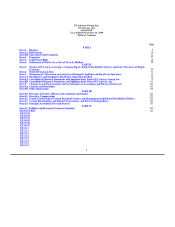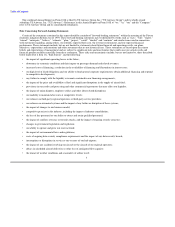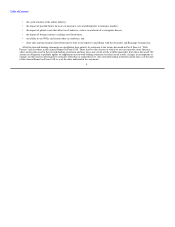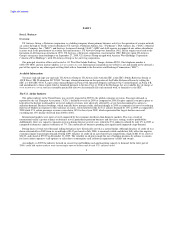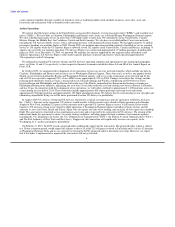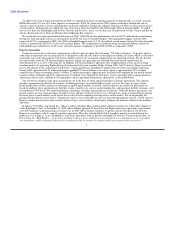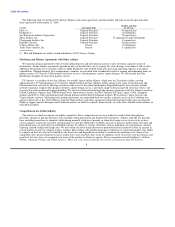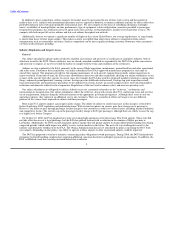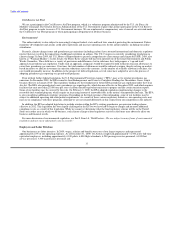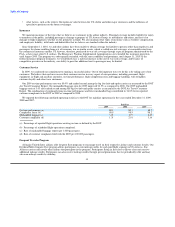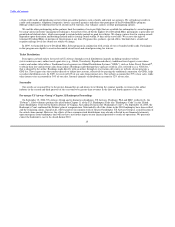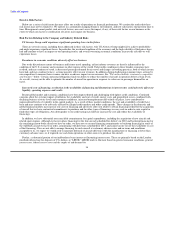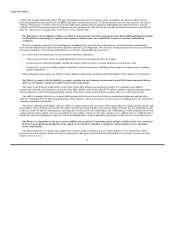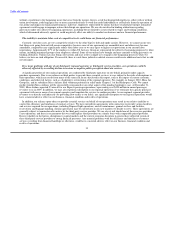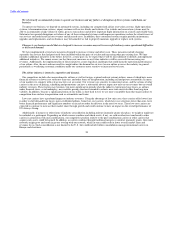US Airways 2009 Annual Report Download - page 13
Download and view the complete annual report
Please find page 13 of the 2009 US Airways annual report below. You can navigate through the pages in the report by either clicking on the pages listed below, or by using the keyword search tool below to find specific information within the annual report.
Table of Contents
Civil Reserve Air Fleet
We are a participant in the Civil Reserve Air Fleet program, which is a voluntary program administered by the U.S. Air Force Air
Mobility Command. The General Services Administration of the U.S. Government requires that airlines participate in the Civil Reserve
Air Fleet program in order to receive U.S. Government business. We are reimbursed at compensatory rates if aircraft are activated under
the Civil Reserve Air Fleet program or when participating in Department of Defense business.
Environmental
The airline industry is also subject to increasingly stringent federal, state and local laws aimed at protecting the environment. Future
regulatory developments and actions could affect operations and increase operating costs for the airline industry, including our airline
subsidiaries.
Recently, climate change issues and greenhouse gas emissions (including carbon) have attracted international and domestic regulatory
interest that may result in the imposition of additional regulation on airlines. The U.S. Congress is currently considering legislation on
climate change. In June 2009, the U.S. House of Representatives passed a comprehensive clean energy and climate bill (H.R. 2454, also
known as "Waxman-Markey"). In the Senate, the Boxer-Kerry climate bill has been reported out of the Senate Environment and Public
Works Committee. These bills have a variety of provisions and differences, but in substance they both propose a "cap and trade"
approach to greenhouse gas regulation. Under such an approach, companies would be required to hold sufficient emission allowances to
cover their greenhouse gas emissions. Over time, the total number of allowances would be reduced or expire, thereby relying on market-
based incentives to allocate investment in emission reductions across the economy. As the number of available allowances declines, the
cost would presumably increase. In addition to the prospect of federal legislation, several states have adopted or are in the process of
adopting greenhouse gas reporting or cap-and-trade programs.
Even without further federal legislation, the U.S. Environmental Protection Agency ("EPA") may act to regulate greenhouse gas
emissions. In December 2009, the EPA issued its final Endangerment and Cause or Contribute Findings for Greenhouse Gases, which
became effective in January 2010. This regulatory finding sets the foundation for future EPA greenhouse gas regulation under the Clean
Air Act. The EPA also promulgated a new greenhouse gas reporting rule, which became effective in December 2009, and which requires
facilities that emit more than 25,000 tons per year of carbon dioxide-equivalent emissions to prepare and file certain emission reports.
Some of our facilities may be covered by this rule. On February 3, 2009, the EPA adopted regulations implementing changes to the
renewable fuel standard program, which require an increasing amount of renewable fuels in the nation's transportation fuel mix. The EPA
is also considering additional regulatory programs. Depending on the final outcome of this rulemaking, some of our facilities may be
subject to additional operating and other permit requirements. As a result of these various regulatory initiatives, our operating costs may
increase in compliance with these programs, although we are not situated differently in this respect from our competitors in the industry.
In addition, the EU has adopted legislation to include aviation within the EU's existing greenhouse gas emission trading scheme
effective in 2012. This legislation has been legally challenged in the EU but we have had to begin to comply and incurred additional
compliance costs as a result of this legislation. While we cannot yet determine what the final regulatory scheme will be in the United
States or in other areas in which we do business, such climate change-related regulatory activity in the future may adversely affect our
business and financial results.
For more discussion of environmental regulation, see Part I, Item 1A, "Risk Factors – We are subject to many forms of environmental
regulation and may incur substantial costs as a result."
Employees and Labor Relations
Our businesses are labor intensive. In 2009, wages, salaries and benefits were one of our largest expenses and represented
approximately 23% of our operating expenses. As of December 31, 2009, US Airways employed approximately 31,300 active full-time
equivalent employees, including approximately 4,100 pilots, 6,800 flight attendants, 6,200 passenger service personnel, 6,100 fleet
service personnel, 3,300 maintenance personnel and
11



